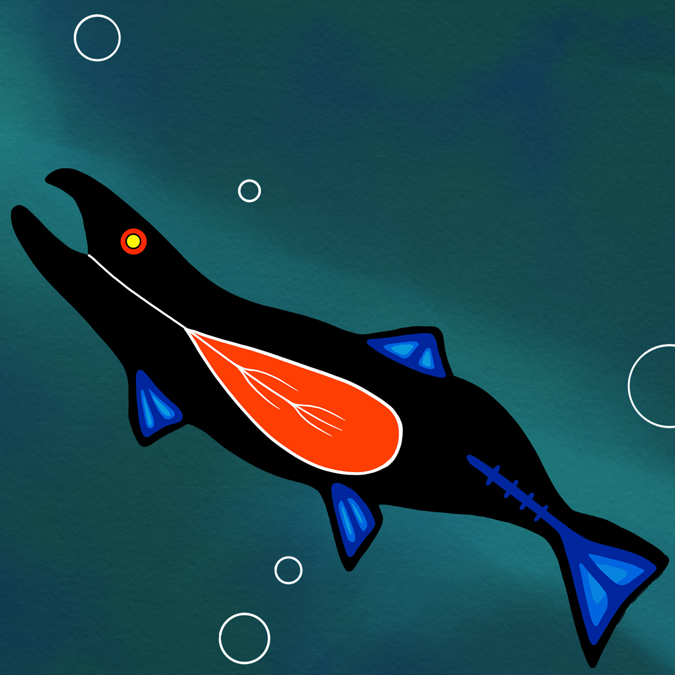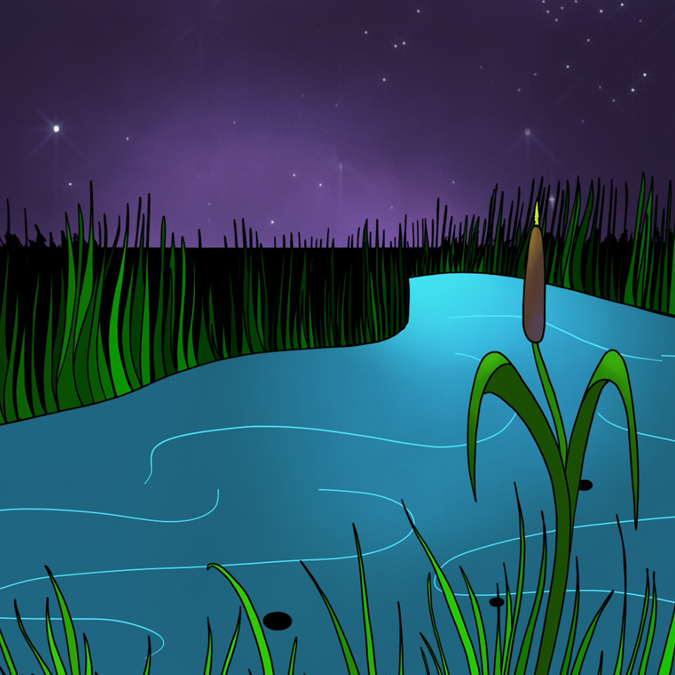The GTA has been home to Indigenous peoples for millennia. Here, Sara Roque and Selena Mills share their reflections on this land
“Aahnii, Boozho, Sara Roque n-dish-ni-kaaz, Shebahonaning n-don-jibaa, Tkaronto in-day.”
“My name is Sara Roque, I am mixed blood Anishinaabekwe from the community of Shebahonaning , colonially knows as Killarney Ontario, and currently living in Toronto.”
The Tkaronto/Toronto of today and of yesterday have three big things in common: cultural diversity, sophisticated means of commerce and complex histories that encompass different viewpoints. The concepts and intellectual passages illuminated in this article and beautifully animated video reflect our perspectives and experiences and a collaborative approach taken to expand upon research done by elders and traditional practitioners we know and seek counsel from. We recognize that what we present conflicts with (some) colonial constructs and research when it comes to the history of a place. We’re not here to denounce anything, but rather to support Indigenous sovereignty by honouring the sophisticated practice of sharing Indigenous worldviews and history in an oral style—and to go beyond the thrust of absoluteness when it comes to western discourse and analysis.

What remains most important to us is acknowledging that we are of the land that our ancestors are from and where we, too, were born, mindful of the seven generations who came before and the seven generations to come. We’ve come together to take a small step in detailing a complicated and rich history that cannot be contained in one single offering of an Indigenous worldview. Indigenous peoples do not all think the same, nor do we all hold the same values. But as the creators of this video, what we hope is that this offering will give non-Indigenous allies a reference point as to why land acknowledgements are becoming more and more popular in Tkaronto and across Canada.
It’s essential to remember that Indigenous peoples are in a time of revitalization, and resurgence, after the pressures of settlement, disease, religious indoctrination and longstanding cultural restriction. We’re not presenting this information as experts, but as stewards who are beholden to the communities we come from, to those who have claimed us and to our relations all across Turtle Island. We take our duty to consult with one another—inside AND outside academic circles—seriously.
There were many migration patterns in what is now known as the Great Lakes region for thousands of years before European settlers arrived. The area was inhabited by many diverse nations of First Peoples, extending beyond the traditional territories of the Wendat, Anishnaabeg, Haudenosaunee, Métis and Mississaugas of the Credit. These are the nations you might now hear as being the original occupants of territories within the GTA, typically being acknowledged orally at an art or civic event or fundraiser, or visually in a museum or arts centre. When I encounter these land acknowledgements, I can’t help but think of what’s missing and of the important connections that are difficult to include in one short announcement. Just how far back should we go when making land acknowledgements? The GTA itself is ensconced in a myriad of complications to do with the Upper Canada Treaties, specifically the lands protected by the “Dish With One Spoon” wampum inter-nation peace agreement. While this agreement may be widely referenced in Tkaronto academic land acknowledgements, there is little to no mention of how it’s been broken, like so many other treaties.

By acknowledging the land, we are all reminding ourselves of our human connection and responsibility to care for the land—and that can’t be done if we aren’t caring for and respecting each other, regardless of cultural lineage. By identifying a First Nations presence, Indigenous peoples are verified as the original inhabitants of Turtle Island, and we have the opportunity to remember ancestral Indigenous burial grounds too. Such acknowledgements also serve as a reminder that First Nations, Métis and Inuit peoples are still negotiating their inherent rights to the land and their relationships to the state—relationships that have been extremely fraught and violent—and trying to truthfully integrate back into the historical narrative of this country.
There is a fascinating Indigenous oral history covered up by the concrete of Toronto today, but those stories are not lost. Toronto itself is a word that originates from the Mohawk word “Tkaronto,” meaning “the place in the water where the trees are standing,” which is said to refer to the wooden stakes that were used as fishing weirs in the narrows of local river systems by the Haudenosaunee and Huron-Wendat. Davenport and Dupont are prominent streets that many of us travel, but did you know that they were built upon some of the original portage trails used by Indigenous peoples for many thousands of years? There were trails like this all over the city. We’ve linked some additional sources for reference and readers’ own continued learning below, including some cool historical sites and parks you can visit that explain these ancient histories in much more detail.
One that had a particularly big impact was the “Shared Path” along the Humber River, because of the intersection at its mouth of two ancient routes, which are thousands of years older than the nearby highways. One travelled along the shifting shoreline of Lake Ontario. The other is a nearly 50-kilometre-long footpath known today as the Carrying Place Trail. This was an ancient portage trail that ran northward along the banks of the Humber River as far as Lake Simcoe—an ancestor of today’s Yonge Street and Highway 400! We’re going back 11,000 years, which is a reminder of the sophisticated and cosmopolitan nature of Indigenous people then, something we can all see reflected in the rich multicultural landscape of Tkaronto today.

Indigenous peoples from all over would travel these waterways. There was a brilliant water-powered industry and a thriving gathering place for trade and commerce all around the Great Lakes area where people gathered and grew food, hunted for game, trapped, fished and, eventually, traded furs with the French as the pressures of settlement and disease encroached. Even the development of those original paths has a fascinating oral history. The animals native to this area then (deer, river otter, coyote and even wild turkey) were the ones who began clearing the routes. They inherently knew the best ways to travel and needed to be near the water, too. Indigenous peoples respected the wisdom of their animal cousins and those animal paths eventually became human-used portage trails to travel to gather for negotiations and ceremony as well as the trade and commerce I mentioned, often in tandem from trail path to river. How did these rivers come to be paths? The Humber watershed was dramatically altered by the deforestation of the 1800s. Its water levels changed, pollution destroyed its fishery and landfill changed its river banks—including at the river’s mouth, so naturally, that water flowed into those paths as colonization and settlement continued.
The treaty that was signed for this particular land is collectively referred to as the Toronto Purchase and applies to land from Brown’s Line in the west to Woodbine Avenue in the east, and from the shore of Lake Ontario north toward Newmarket. This is an example of the many environmentally and culturally exploitive land agreements that were made across Turtle Island in which all so-called agreements were in fact in the best interests of the settlers—not in the spirit of the well-being of the land and future generations to come.
In this new era of Truth and Reconciliation, people are yearning for the truth as the first step towards repairing fractured relationships. Including accurate and honest Indigenous histories in our national consciousness means understanding and talking more about the deep impact of colonization—including, but not limited to, residential schools and the ’60s Scoop—as well as highlighting the positive contributions Indigenous folx have made and continue to make as strong, intelligent, remarkable individuals. As such, Indigenous peoples should be included and consulted with in every stage of reconciliation work such as land acknowledgements, where we are a part of sharing these stories in our own ways—beyond the token stage. Land acknowledgements might seem like a small and simple gesture, but like many of our Indigenous ways, they are designed to evolve and hopefully hold much more meaning than the words alone—and to allow us to re-imagine the real story of this land, together.
SOURCES
• University of Toronto Libraries: The Indigenous History of Tkaronto
• The Two Row Times: A paper serving the dish with one spoon territory – Great Lakes Region
• Muskrat Magazine: Toronto, aka Tkaronto, passes new city council protocol
• First Nations House Magazine
• Taiaiako’n Historical Preservation Society: Protecting High Park burial mounds
• Toronto Public Library: Indigenous Toronto: Takwaakin in the City
• Toronto Public Library: Seegwun: Cleansing and Resurgence
• Ontario Association of Landscape Architects: Landscape Architecture and Indigenous Territories
• Torontoist: Historicist: The Tabor Hill Ossuary
• Canadian Association of University Teachers: Guide to Acknowledging First Peoples and Traditional Territory
• Alternatives Journal: Living on Stolen Land
• Toronto Discovery Walks: Humber River, Old Mill & Marshes